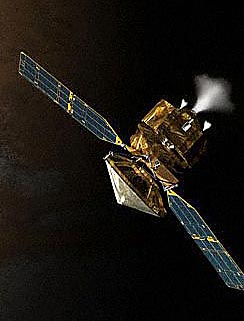Hitch delays Nasa's Mars launch

The Mars Reconnaissance Orbiter, which has new tools designed to gather more data on the planet than all previous Martian missions combined, was due to take off from the Kennedy Space Center in Florida.
Initially the take-off was said to have been delayed when early morning thunderstorms delayed fuelling of the rocket launching the orbiter.
Later, however, the launch was postponed by at least a day when the manufacturer reported the failure in testing of a gyro similar to two used in the Altas V launch rocket.
The orbiter is expected to spend four years circling Mars. It is due to collect information that will help Nasa plan where to land two robotic explorers later this decade and possible future human exploration of the Red Planet.
The Phoenix Mars Scout, in search of organic chemicals, will be launched in 2007, and the Mars Science Laboratory will follow two years later.
"We don't want to be hauling cement to Mars. That's very expensive," said project scientist Richard Zurek, of the Jet Propulsion Laboratory in Pasadena, California. "Better to know what we can make on the surface of the planet."
The two-ton orbiter, equipped with the largest telescopic camera ever sent to another planet, will provide unparalleled information on Mars' weather, climate and geology. The $720m mission is also expected to help build on NASA's knowledge of the history of ice on the planet.
The planet is cold and dry with large caps of frozen water at its poles. But scientists think it was a wetter and possibly warmer place eons ago — conditions that might have been conducive to life. Scientists are also trying to determine if it could support future human outposts.
"With the subsurface of Mars, we've literally just scratched the surface and we're trying to probe, now, more than a couple of feet into it," Zurek said.
The orbiter will join three other spacecraft, including a European orbiter, when it arrives at the planet in March 2006. Two NASA rovers launched in 2003, Spirit and Opportunity, also continue to roam the planet, providing information water on Mars.
With more instruments and higher-resolution imagery, the larger Mars Reconnaissance Orbiter will be able to offer a more comprehensive sweep of the planet and send back more data than the other orbiters, said project manager Jim Graf, of the Jet Propulsion Laboratory.
It has a powerful antenna that can transmit 10 times more data per minute than the current trio of satellites positioned around the planet — NASA's Global Surveyor and Mars Odyssey and the European Space Agency's Mars Express.
The orbiter is also loaded with two cameras that will provide high-resolution images and global maps of Martian weather, a spectrometer that will identify water-related minerals and a radiometer to measure atmospheric dust. The Italian Space Agency has provided ground-penetrating radar that will peer beneath the surface of layers of rocks or ice.
"They're bringing their data back, we think, through a straw," Graf said of the current orbiters. "We're going to start opening up the fire hose ... We're going to be awash in data that will allow us to better understand the planet as a whole."
Join our commenting forum
Join thought-provoking conversations, follow other Independent readers and see their replies
Comments
Bookmark popover
Removed from bookmarks